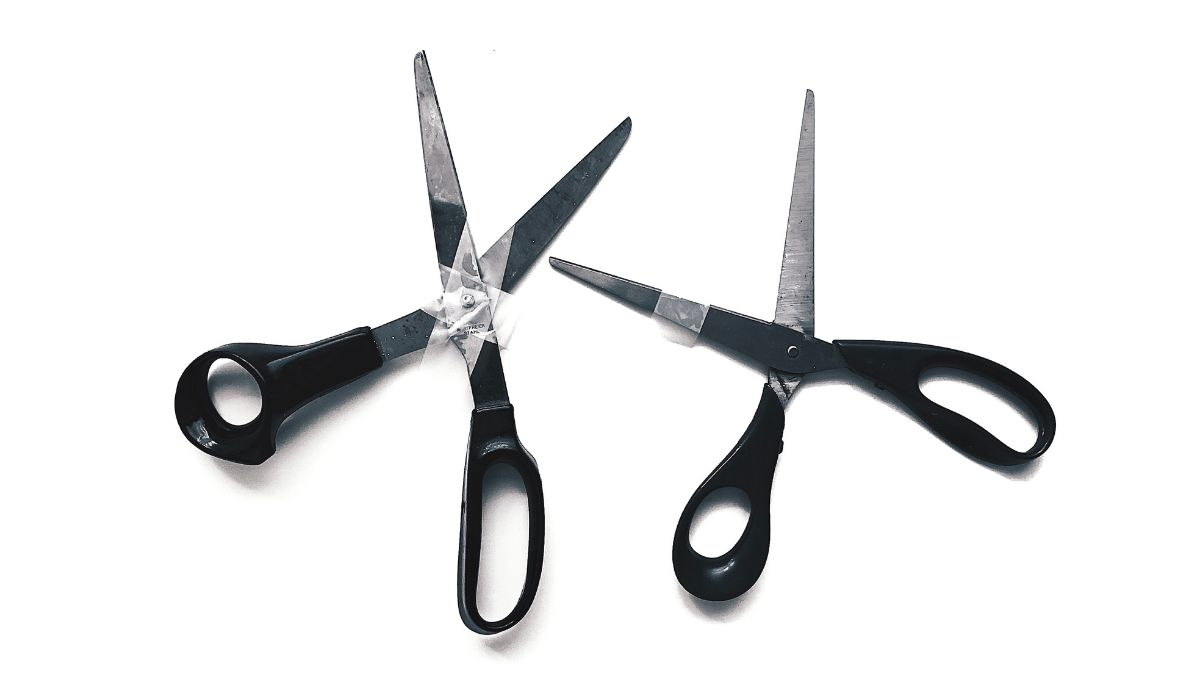Can You Bring Scissors On A Plane? A Guide to Packing Sharp Objects for Your Flight

As participants in Amazon Associates and other programs, we earn from qualifying purchases. This comes at no additional cost to you. For more details, see our Affiliate Disclosure.
Flying can be a convenient and fast way to travel, but it also comes with certain restrictions and regulations when it comes to what you can bring on board. If you’re someone who needs to pack sharp objects for your trip, like scissors, you may be wondering if you’re allowed to bring them on a plane. The answer isn’t always straightforward, as there are various factors to consider, such as the type and size of the scissors, as well as the airline’s specific policies.
To help you navigate the process of packing sharp objects for your flight, this article will provide a comprehensive guide on bringing scissors on a plane. We’ll discuss the different types of scissors and their potential risks, as well as the Transportation Security Administration’s (TSA) guidelines on what you can and cannot bring on board. By the end of this article, you’ll have a better understanding of how to pack your scissors safely and avoid any issues at the airport.
Understanding TSA guidelines on sharp objects
When it comes to packing sharp objects for your flight, it’s important to understand the guidelines set forth by the Transportation Security Administration (TSA). The TSA is responsible for ensuring the safety of passengers and crew on flights within the United States, and they have specific rules regarding what you can and cannot bring on board.
According to the TSA, sharp objects like scissors are allowed in both carry-on and checked baggage, as long as they meet certain criteria. The blades of the scissors must be less than 4 inches in length, and the scissors must have blunt tips. Any scissors that exceed these measurements will need to be packed in your checked luggage.
It’s worth noting that even if your scissors meet the TSA guidelines, they may still be subject to additional screening. If the TSA agent deems your scissors to be a potential threat, they may ask you to surrender them or place them in your checked luggage. To avoid any issues, it’s recommended that you pack your scissors in a way that is easily accessible for inspection.
Types of scissors and their potential risks
When it comes to packing scissors for your flight, it’s important to consider the type of scissors you’re bringing and their potential risks. Different types of scissors can have different levels of danger, depending on their size, shape, and intended use.
Some common types of scissors that you may need to pack for your trip include:
- Household scissors: These are typically used for cutting paper, fabric, and other lightweight materials. They are usually small enough to fit in your carry-on luggage and can be packed safely as long as they meet the TSA guidelines.
- Craft scissors: These are designed for more intricate cutting tasks, such as scrapbooking or embroidery. They may have sharper blades or unique shapes, which could potentially raise red flags during the TSA screening process.
- Medical scissors: These are often used in healthcare settings for cutting bandages, gauze, or clothing during emergency situations. They may have longer blades or be made of sharper materials, which could be seen as a potential threat by TSA agents.
- Kitchen scissors: These are used for cutting food items such as meat, poultry, and vegetables. They may have serrated edges or be equipped with additional features like bottle openers or nutcrackers, which could raise suspicion during the screening process.
It’s important to pack each type of scissors appropriately, taking into account its potential risks and intended use. For example, medical scissors should be accompanied by a physician’s note or prescription, and kitchen scissors should be thoroughly cleaned and packed in a way that prevents any contamination. By being aware of the potential risks associated with different types of scissors, you can ensure a smooth and stress-free travel experience.
Packing scissors in checked luggage
If your scissors exceed the TSA guidelines for carry-on luggage, you’ll need to pack them in your checked luggage instead. Here are some tips for packing scissors safely in your checked bag:
- Use a protective case: Place your scissors in a sturdy case or sheath to prevent them from moving around and potentially damaging other items in your bag.
- Wrap the blades: To further protect your scissors and prevent damage, wrap the blades in a layer of bubble wrap or paper towels. This will also help to keep the blades from accidentally opening during transit.
- Pack in the middle: When placing your scissors in your checked luggage, pack them in the middle of your bag, surrounded by soft items like clothing or towels. This will provide an additional layer of protection and help to prevent damage.
- Label your bag: Be sure to label your checked bag with your name, contact information, and destination address, in case it gets lost or misplaced during transit.
It’s important to note that while packing your scissors in checked luggage may be a safe option, there is still a risk of them being damaged or lost during transit. Additionally, if your checked bag exceeds the weight limit or size restrictions set by your airline, you may incur additional fees.
Packing scissors in carry-on luggage
If your scissors meet the TSA guidelines for carry-on luggage, you can pack them in your carry-on bag. Here are some tips for packing scissors safely in your carry-on luggage:
- Place them in a clear plastic bag: Place your scissors in a clear plastic bag before putting them in your carry-on luggage. This will make them easy to identify during the TSA screening process.
- Choose a protective case: If you have a larger or more expensive pair of scissors, consider investing in a protective case or sheath to prevent them from getting damaged during travel.
- Pack them strategically: Place your scissors in a pocket or compartment of your carry-on bag that is easily accessible for the TSA agents to inspect. This will help speed up the screening process and prevent any delays.
- Be prepared to surrender them: Even if your scissors meet the TSA guidelines, there is still a chance that they may be confiscated if the TSA agent deems them to be a potential threat. If this happens, you will need to surrender them or place them in your checked luggage.
By following these tips, you can pack your scissors safely in your carry-on luggage and avoid any issues at the airport. Remember to always follow the TSA guidelines and be prepared for the possibility of your scissors being confiscated.
Tips for safely transporting scissors
Whether you’re packing scissors in your carry-on or checked luggage, here are some tips to ensure that they are transported safely during your trip:
- Choose the right type of scissors: Consider the type of scissors you need for your trip and choose the appropriate size and design. If you’re unsure whether your scissors meet the TSA guidelines, contact your airline before your trip.
- Pack them properly: Use a protective case or sheath to prevent your scissors from getting damaged during transit. If you’re packing them in your checked luggage, wrap the blades in bubble wrap or paper towels for extra protection.
- Label your bag: Be sure to label your checked bag with your name, contact information, and destination address, in case it gets lost or misplaced during transit. This will also make it easier for airport staff to return your bag to you if your scissors are confiscated.
- Follow TSA guidelines: Always follow the TSA guidelines for packing sharp objects, including scissors. This will help to avoid delays and potential confiscation of your scissors.
- Consider alternative cutting tools: If you’re not sure whether your scissors will be allowed on board, consider using an alternative cutting tool for your trip, such as a travel-sized pair of safety scissors or a craft knife with a retractable blade.
By following these tips, you can safely transport your scissors and ensure a stress-free travel experience. Remember to always prioritize safety and follow the TSA guidelines to avoid any issues at the airport.
Alternatives to scissors for your trip
If you’re concerned about packing scissors for your trip or if your scissors don’t meet the TSA guidelines, there are several alternative cutting tools you can consider bringing instead. Here are some options:
- Travel-sized safety scissors: These small scissors have blunt tips and short blades, making them safe to pack in your carry-on luggage.
- Retractable craft knife: A craft knife with a retractable blade can be a useful alternative to scissors for cutting paper, fabric, or other lightweight materials. Make sure to pack it in your checked luggage.
- Portable rotary cutter: A portable rotary cutter is a lightweight cutting tool that can easily fit in your carry-on luggage. It’s designed to cut through fabric and other materials with precision.
- Folding utility knife: A folding utility knife is a versatile cutting tool that can be used for a variety of tasks. It can be packed in your checked luggage, but make sure to remove the blade before packing.
- Scissors at your destination: If you’re traveling for a specific purpose, such as a craft workshop or a medical conference, consider buying a pair of scissors at your destination instead of packing them with you.
By considering these alternative cutting tools, you can still have the necessary tools to complete your tasks during your trip, without having to worry about the TSA guidelines or potential confiscation of your sharp objects.
Dealing with confiscated sharp objects at the airport
If your sharp object, such as scissors, is confiscated by TSA at the airport, it can be a frustrating experience. However, it’s important to remember that TSA’s primary concern is safety and security, and they have the authority to confiscate any item that they believe could pose a threat to passengers and crew. If your scissors are confiscated, the TSA will typically offer you the option to either surrender them or place them in your checked luggage.
If you choose to surrender your scissors, TSA will dispose of them in a secure manner. However, if your scissors have sentimental or financial value, or if they are essential for your trip, you may want to consider placing them in your checked luggage instead. It’s important to note that if you decide to place your scissors in your checked luggage, they must comply with the TSA guidelines for sharp objects in checked luggage. Otherwise, they may still be confiscated at the airport.
If you’re unsure about whether your scissors will be allowed on board, it’s always best to contact your airline or the TSA directly for guidance. You can also review the TSA’s website for a list of prohibited items, as well as tips on how to pack sharp objects safely for your trip. Remember to always prioritize safety and comply with TSA guidelines to ensure a smooth and stress-free travel experience.
Exceptions to the rules: bringing scissors for medical reasons
While the TSA has strict guidelines on packing sharp objects for air travel, there are some exceptions to the rules for passengers who require certain sharp objects for medical reasons. This includes individuals who need to bring medical scissors or other cutting instruments on board with them.
If you need to bring medical scissors with you on your flight, it’s important to carry a doctor’s note or prescription that explains the necessity of the scissors. You should also contact your airline prior to your trip to inform them of your needs and make arrangements for any necessary accommodations.
When going through the TSA screening process, make sure to inform the agent that you have medical scissors in your carry-on luggage. The TSA agent will likely ask to see your doctor’s note or prescription, and may also need to inspect the scissors before allowing you to board the plane.
It’s important to note that the TSA may still confiscate your medical scissors if they are deemed to be a potential threat to other passengers or the crew. To avoid any issues, make sure to follow all TSA guidelines and be prepared to surrender your scissors if necessary.
Different airline policies on scissors
While the TSA has established guidelines on packing sharp objects for air travel, different airlines may have their own policies on scissors and other sharp objects. It’s important to check with your specific airline before your trip to ensure that you’re in compliance with their policies.
Some airlines may have stricter policies than the TSA, while others may have more lenient policies. For example, some airlines may allow scissors with longer blades in carry-on luggage, while others may not allow any sharp objects in carry-on luggage at all.
In addition to blade length, some airlines may also have restrictions on the type of scissors that are allowed on board. For example, some airlines may prohibit scissors with curved blades or serrated edges.
To avoid any issues at the airport, it’s important to research your airline’s policies and guidelines before your trip. You can typically find this information on the airline’s website or by contacting their customer service department directly.
Remember that even if your scissors are allowed on board by your airline, they may still be subject to additional screening by the TSA. By being aware of the different airline policies on scissors, you can pack your sharp objects safely and avoid any potential conflicts at the airport.






